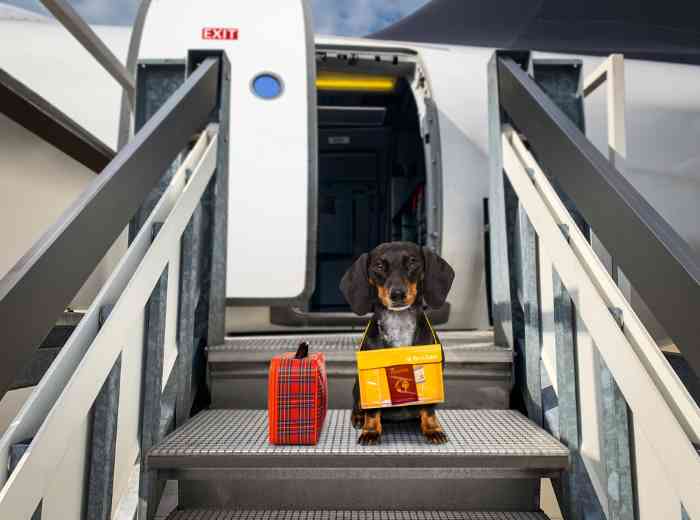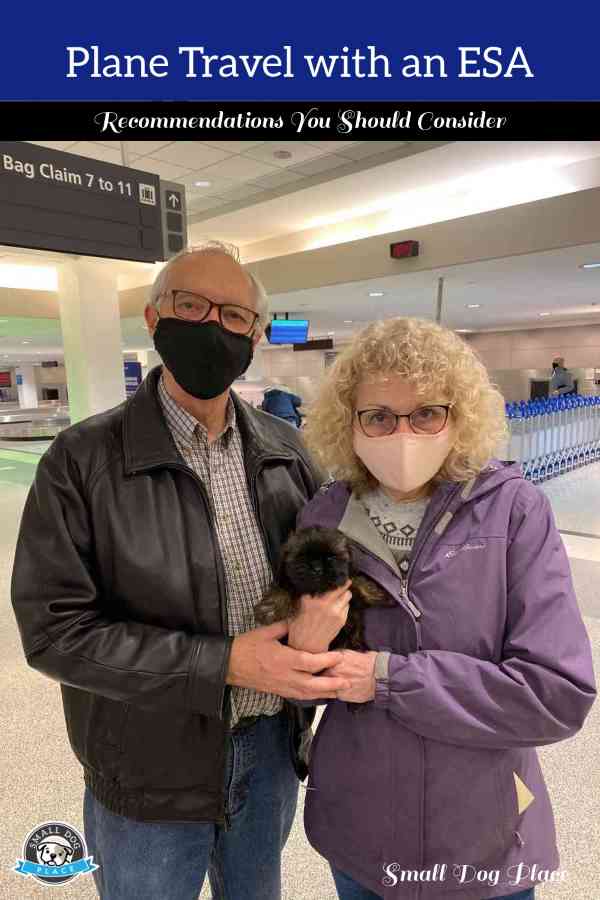- Small Dog Place Home
- Lifestyle
- Plane Travel With an ESA
Plane Travel with an ESA: What You’ll Need to Know
Plane Travel with an ESA by Amy Adams |Published 01-29-2021
The public perception of service animals and emotional support animals might not make much of a distinction between the two, but in most cases they actually have very different roles.
 Plane Travel with an ESA
Plane Travel with an ESAInterestingly enough, airlines have also made very little distinction between service animals and ESAs; this is because they follow the definitions used by the Air Carrier Access Act, and not the Americans with Disabilities Act.
For years, ESAs and service animals have been in the same category when it comes to air travel; as such, the main requirement the owner had to comply with was additional documentation from a mental healthcare provider that verified the status and purpose of the animal.
Changing Regulations for Plane Travel with an ESA
About a year ago, the DOT announced that it would be changing the regulations regarding service animals and air travel. The changes covered several points:
Definition of Service Animal
The definition of a “service animal” would be updated. This is where the biggest change will be for ESA owners – the new definition is much more specific, and excludes their animals from the “service animal” status they had before.
The new definition specifies that the service animal is a dog, and states that it should have received training for a task that will mitigate the effects of their owner’s disability. This disability could be physical, psychiatric, sensory, or intellectual; the main thing is that the dog has been trained to help with it.
Since ESAs don’t typically receive training to do their jobs, this effectively rules them out. Now that airlines won’t consider them to be service animals anymore, the new regulations will consider ESAs to be essentially the same as ordinary pets.
The Term Service Animal Basically Mean Service Dog
The term is “service animal”, but what it will really mean is “service dog”. Yes, some trained service animals are actually miniature horses, but most of them are dogs, and according to the DOT, dogs are the only species that will be allowed to board airplanes under the new regulations.
This means that airlines will be able to deny entry not only to miniature horses, but also rabbits, birds, cats, pigs, and every other species that the current rules support.
New Document Requirements
Along with the new definitions, there will be new document requirements. The DOT has announced that it will now require three documents for each service animal; no more additional paperwork for owners of psychiatric service animals.
There will be one document that certifies that the animal is healthy; a second document that guarantees the training and good behavior of the animal; and a third document stating that the animal has been trained on how to relieve itself appropriately in a public situation.
New Options Given to Airlines
The DOT will give airlines the option to require earlier check-in for service animals for paperwork processing and observation.
Even though the new regulations would be eliminating a lot of unruly animals from the passenger area, it’s still the responsibility of the airline to make sure that they don’t allow animals to board if they could pose a threat to the other passengers.
Possible Early Check-in
With that in mind, airlines might require service animal owners to present their animals and paperwork up to one hour prior to general check-in, so that the staff can check that the paperwork is in order, and confirm that the animal isn’t aggressive or out-of-control.
Check-in requirements vary from airline to airline, but ESA owners might have to give up to 48 hours’ notice if they’ll be taking their animal onto the plane.
Limits on Size and Number of Service Animals
Airlines would be able to limit the size and number of service animals brought on by one passenger. There aren’t currently any limitations on the size or weight of service animals (including ESAs), but the updated regulations would require each service animal to fit on their owner’s lap or underneath their seat. Each person could also bring no more than two service animals with them on a flight.
Animal Restraints and Control
Service animal owners will have to restrain their animals appropriately. This could mean a harness or any kind of leash; the main thing is that the service animal isn’t allowed to roam freely throughout the plane cabin.
If an animal is clearly disruptive, aggressive, or hyperactive, it won’t be allowed onto a plane no matter what its technical status is.
Exclusion of Certain Species
Airlines won’t be allowed to exclude certain breeds of animals, but they’ll continue to exclude certain species.
Currently, airlines don’t allow reptiles, snakes, rodents, spiders, or sugar gliders onto planes.
Required Documentations for Plane Travel with an ESA
 Plane Travel with an ESA Documentations Needed
Plane Travel with an ESA Documentations NeededThe new rules aren’t in effect yet – what documents do I need for my ESA under the current regulations?
1. Letter From Your Mental Health Provider
You’ll need three documents, and probably the most important one is the letter you’ll need from your mental healthcare provider. This letter should have the following characteristics:
- It should be dated less than a year from your travel date
- It should state that the ESA owner has a recognized emotional or mental disability (there’s no need for the letter to specify the nature or identity of their disability)
- It should confirm that the support animal is necessary for them to function or travel
- It should specify that the professional writing the letter is fully licensed to practice their profession, and that they are providing healthcare services to the individual with the letter
- It should include relevant information on the mental healthcare provider’s license, including the type of license, date of validity, and the issuing authority of the license
- And finally, it should include the signature of the mental healthcare provider
3. Documentation from the Veterinarian
The second document you’ll need will come from your support animal’s veterinarian. The form should be less than one year old; it should include information on:
- The type and breed of the animal
- The weight of the animal (if it’s 20 pounds or more)
- The animal’s most recent vaccinations, particularly for rabies and distemper (for certain breeds)
This document should include a statement from the vet regarding the suitability of the animal for plane travel. For certain animals, the vet might recommend additional measures like a crate or a muzzle, or they might say that the animal should be crated and put in with the cargo.
Since a vet will know the animal’s behavior patterns much better than airline staff, these recommendations are important to have.
Lastly, the vet’s contact information and license details should be on the document.
This would include the type and date of license, the license number, the issuing authority of the license, the veterinary practice’s email address and phone number, as well as the name/signature of the veterinarian.
3. Good Behavior Guarantee in Writing
The third letter you’ll need is a guarantee of good behavior. It isn’t required by every airline, and there’s no standard format to follow; essentially, it’s documentation that your support animal has received some kind of training on how to act in public.
It’s your personal guarantee that you’ve taken the necessary steps to ensure that your animal won’t be a nuisance to other passengers. This will probably include a certificate of training, and your personal contact information.
Each airline has its own requirements on when to turn in these forms, so make sure you check at least a week beforehand so there aren’t any unpleasant surprises the day of your trip.
The ethical side of Traveling with an Emotional Support Animal
Various travel authorities and airlines can impose regulations that’ll weed out the worst-behaved animals, but at the end of the day, your animal is your responsibility.
Even if you know you can comply with the requirements, there’s still a question of whether or not you can keep your animal from bothering the other passengers. If you aren’t sure what that entails, here are a few tips:
Tips and Recommendations for Plane Travel with an ESA
- Keep some kind of restraint – like a leash or a harness – on your animal from the time you leave the house to the time you reach your destination. If you have a service animal, think about getting a special harness that identifies it as such.
- Make sure your support animal knows how to take care of it’s business in public, or how to notify you (like during a longer plane ride).
- Unless you absolutely need your support animal to be on your lap, it’s best for the animal and the other passengers if it can stay in your foot space or underneath your plane seat. It’s less disruptive for everyone involved, especially if any nearby passengers have pet allergies.
- Service animals are trained not to interact with other people, but ESAs might be used to people petting them. Your ESA should ideally keep to itself, as overly friendly animals can make other passengers feel like it’s out-of-control.
Last Words about Plane Travel with an ESA
With story after story about problematic ESAs making their rounds on the internet, the public eye is definitely focused on support animals.
The new regulations might feel a little reactionary, but this is the solution we’re getting. The best any ESA owner can do is not only make sure they’re complying with the regulations, but also ensure that their animal has the right training and temperament for stressful plane travel.
With some thoughtfulness and planning ahead, everyone involved – including support animals – can have a much better travel experience.
Pin for Future Reference
Author Bio, Plane Travel with an ESA
Amy Adams is an animal lover and community outreach person for the National Service Animal Registry. She has an 8-year old yellow lab named Girl and they love to canoe together. When Amy isn't working with animals or Girl, she likes to read classical literature and write.
Did you find this article, Plane Travel with an ESA Helpful...
Author Bio, Plane Travel with an ESA
About Janice (author and voice behind this site)
Having lived with dogs and cats most of her life, Janice served as a veterinary technician for ten years in Maryland and twelve years as a Shih Tzu dog breeder in Ohio.
Her education includes undergraduate degrees in Psychology with a minor in biology, Early Childhood Education, and Nursing, and a master's in Mental Health Counseling.
She is a lifelong learner, a dog lover, and passionate about the welfare of animals. Her favorite breed for over 50 years has been the Shih Tzu, but she has also lived with Poodles, Maltese, Yorkshire Terriers, Beagles, English Bulldogs, Carin Terriers, and a Cocker Spaniel.
When not writing, reading, and researching dog-related topics, she likes to spend time with her eight Shih Tzu dogs, husband, and family, as well as knitting and crocheting. She is also the voice behind Miracle Shih Tzu and Smart-Knit-Crocheting
Does This Article Deserve Your Thumbs Up?
We always appreciate your support and encouragement. Your thumbs up means so much to us. Please like this article.
If you find this page or any page on Small Dog Place Helpful, or useful in anyway, I'd love it if you would click the small heart found on the bottom right of each page.
You can also share or bookmark this page -- just click on the:

Free Monthly Newsletter
Sign Up for Our Free Newsletter and get our Free Gift to You.
my E-book, The Top 10 Mistakes People Make When Choosing a Dog (and how to avoid them)







